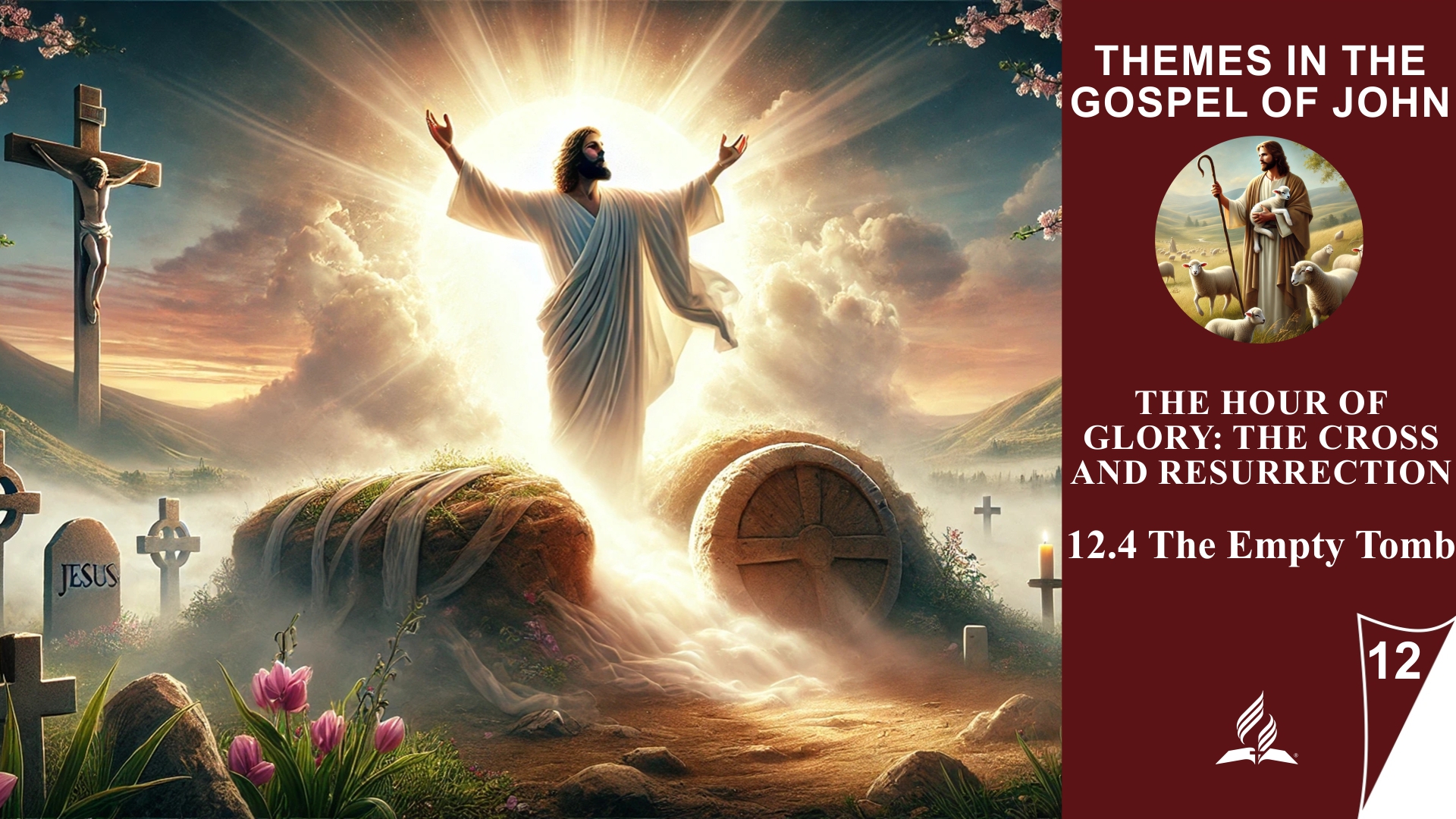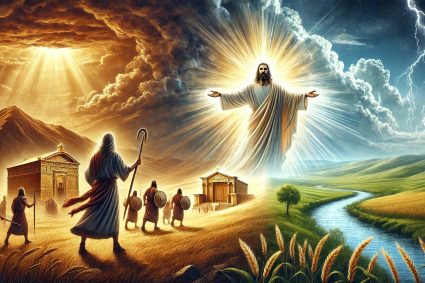


12.4 The Empty Tomb
The Empty Tomb: A Sign of Resurrection and Hope
Read John 20:1–7. What significance does what is described in these verses have for us?
The empty tomb is the heart of the Christian faith. In John 20:1–7, it becomes clear that Jesus’ resurrection is not a misunderstanding or a myth, but a carefully documented fact with deep significance.
-
The Significance of the Empty Tomb
The empty tomb testifies to Jesus’ resurrection, which confirms the victory over death and sin. The disciples’ faith was not founded on speculation or emotions, but on the clear reality that the tomb was empty.
-
Lesson for Us: The empty tomb gives us the assurance that Jesus is truly alive. This is the foundation of our hope and our faith in the resurrection and eternal life.
-
The Details of the Linen Cloths
The linen cloths and the carefully folded sweat cloth indicate that Jesus’ resurrection was not a chaotic or criminal event (e.g., grave robbery). The orderliness suggests that something supernatural occurred.
-
Lesson for Us: The details emphasize God’s power and sovereignty. His plans are perfect and bring order to apparent chaos.
-
The Reaction of the Witnesses
Mary Magdalene, Peter, and John represent different reactions to the empty tomb: confusion, curiosity, and ultimately faith. John, who sees the empty tomb and the cloths, believes (John 20:8), even though he does not yet fully understand the resurrection.
-
Lesson for Us: Faith often begins with seeing and recognizing God’s works. Like John, we are invited to believe even if we do not fully understand everything.
-
The Significance for Our Daily Lives
The empty tomb reminds us that death is not the end and that God is capable of creating new life even from the most hopeless situations. Jesus’ resurrection is proof of God’s faithfulness and power.
-
Lesson for Us: We can trust that God’s power and love are greater than any darkness in difficult moments. His resurrection power can also transform our lives.
Conclusion
The empty tomb is not just a historical event but a personal invitation to believe in the resurrection power of Jesus. It challenges us to live in the hope and assurance that death is defeated and that new life is possible—in this life and beyond.
Read John 20:8–10. What significance did the folded sweat cloth have?
The folded sweat cloth in the empty tomb holds deep symbolic and practical significance. It was one of the crucial details that led John to believe that Jesus had indeed risen.
-
A Sign of Order and Intention
The carefully folded sweat cloth shows that Jesus’ resurrection was not a chaotic or hasty event, as one would expect from a grave robbery. It points to an orderly and intentional action—a supernatural event that reveals God’s power and planning.
-
Lesson for Us: God’s actions are never random or chaotic. The folded sweat cloth reminds us that God has order and intention in everything He does, even in seemingly hopeless moments.
-
A Sign of the Resurrection
Grave robbers would not have had time to arrange the cloths so carefully. John understood that the folded sweat cloth was a sign that Jesus had not simply “disappeared” but had risen by His own power and under divine control.
-
Lesson for Us: Jesus’ resurrection is not a myth but a historical and supernatural reality. The folded sweat cloth reminds us that the victory over death was a planned and completed act of God.
-
Faith Without Complete Understanding
John saw the cloths and believed, even though he did not yet fully understand the resurrection (John 20:9). The folded sweat cloth was visible evidence that transformed his initial confusion into faith.
-
Lesson for Us: Often, we do not fully understand God’s ways, but we are invited to believe and trust Him even when the whole truth remains hidden.
-
A Personal Invitation to Faith
The folded sweat cloth had a clear message for John: Jesus lives! It was a silent yet powerful indication that the promise of resurrection had been fulfilled.
-
Lesson for Us: We are also invited to recognize the traces of God’s work in our lives. The folded sweat cloth reminds us that Jesus lives today and invites us to believe in Him and trust His promises.
Conclusion
The folded sweat cloth in the empty tomb is more than just a detail—it is a symbol of the resurrection, order, and an invitation to faith. It shows us that God is sovereign in all He does and that we can trust Him even when we do not fully understand. Like John, we are invited to see and believe.
The empty tomb and Jesus’ resurrection are not only historical events but have a transformative significance for our faith and daily lives.
-
Hope in Hopeless Moments
-
-
Significance for Daily Life: The empty tomb shows that God can bring new life even from the most seemingly hopeless situations. When we face difficulties, loss, or disappointments, we can trust that God’s power and love are greater than any darkness.
-
Example: In personal crises, we can remember the resurrection, which shows us that God always creates a way from darkness to light.
-
-
Faith Even Without Complete Understanding
-
-
Significance for Daily Life: John believed even when he did not fully understand the resurrection (John 20:8–9). This reminds us that faith does not always mean comprehending everything, but trusting that God is acting, even when we do not immediately see His ways.
-
Example: When we are uncertain or do not understand God’s actions in our lives, we can still trust Him and hold onto His promises.
-
-
A Life Powered by the Resurrection
-
-
Significance for Daily Life: Jesus’ resurrection means that death is defeated and we can live in the power of new life. This hope gives us courage to look to the future with confidence and to let God’s power work in our lives.
-
Example: The resurrection encourages us to let go of old habits or fears and to live a renewed life of love, forgiveness, and joy.
-
-
Order and Intention in God’s Actions
-
-
Significance for Daily Life: The folded sweat cloth shows that God’s actions are never chaotic but always have a clear purpose. Even in difficult times, we can trust that God has a plan that leads us to a good outcome.
-
Example: When our lives seem chaotic or disordered, we can trust that God brings order to our chaos, just as He carefully planned Jesus’ resurrection.
-
-
An Invitation to Faith
-
-
Significance for Daily Life: The empty tomb and the folded sweat cloth invite us to believe in the reality of the resurrection. They challenge us to recognize the signs of God’s work in our lives and to respond accordingly.
-
Example: In our daily lives, we can encounter God in small and large moments—through prayer, in the community of believers, or in experiences that show us that He lives.
-
Conclusion
The empty tomb reminds us that Jesus lives and that we can live in the hope of the resurrection. It invites us to deepen our faith, trust in God’s plan, and shape our lives by His power. In everyday life, this assurance gives us courage, trust, and joy, even in the most challenging moments. The empty tomb is a symbol of hope that transforms our lives.

The empty tomb is a sign of hope: In Jesus, the resurrection defeats every darkness and gives us new life.
Visited 116 times, 1 visit(s) today








